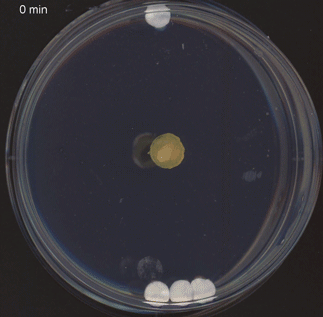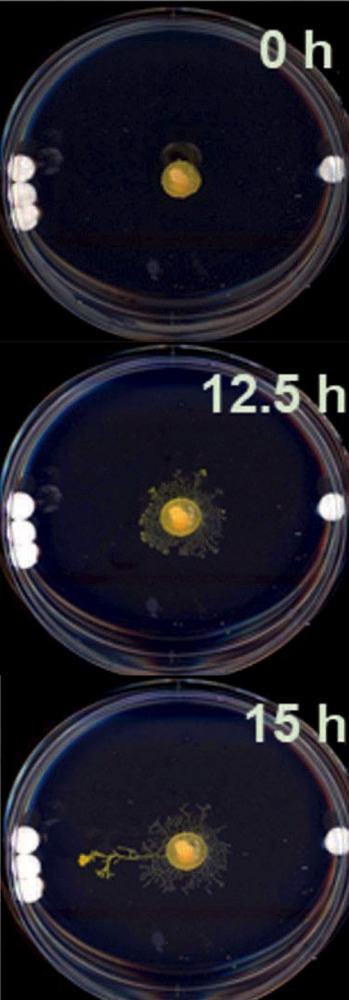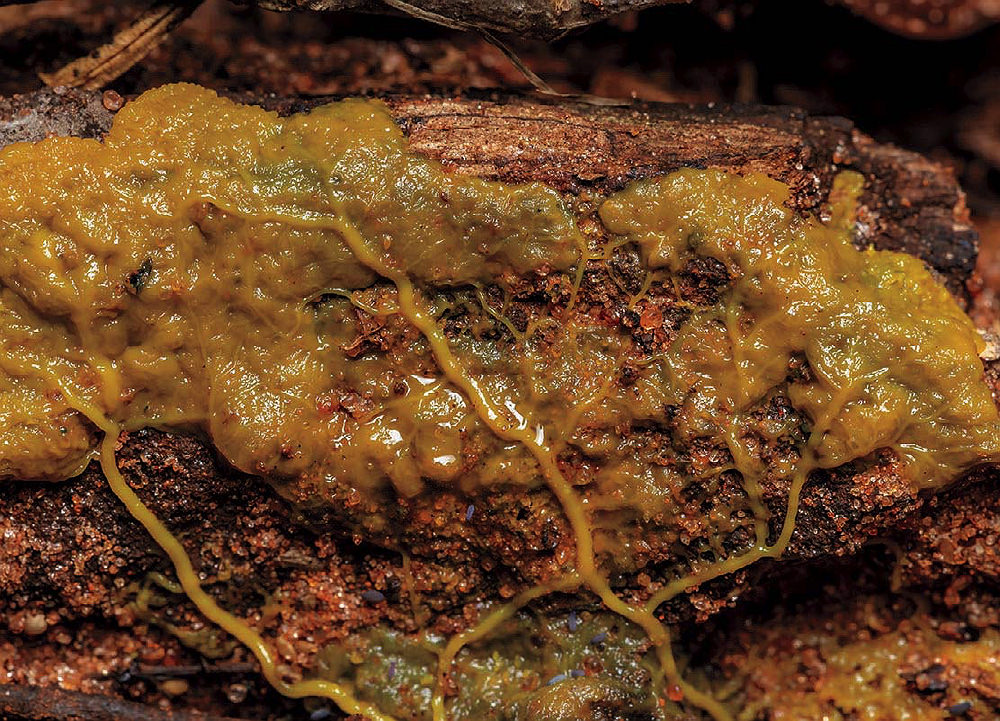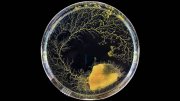Slime mold doesn’t look like much, really. The bright yellow protist goes by many names: ninth-century Chinese scholar Twang Ching-Shih called it “demon droppings”; Carl Linnaeus referred to it as “rotting mucus”; and Dallas residents who watched slime mold crawl across their yards in the 1970s branded it “the blob.” To the scientists now making it a subject of serious study, it is Physarum polycephalum—a unicellular organism that grows to be centimeters-to-meters large and sometimes contains thousands of nuclei. Although slime molds lack eyes, ears, and a brain, they're smart. They keep time: if blown with cold air on the first of every hour, by the third hour, they’ll retract just before the cold snap. They exhibit memory, remembering the locations of food sources, as well as problem-solving skills, completing complex mazes in search of oatmeal. They can even recreate the hyper-efficient Tokyo subway map when oat flakes—their favorite food—stand in for population centers.
Now, researchers at Harvard’s Wyss Institute for Biologically Inspired Engineering and the Allen Discovery Center at Tufts University have discovered another thing Physarum can do: detect objects at a distance without physically coming into contact with them. The sightless slime mold uses its body to sense objects (in a process called mechanosensation) and then decides whether to grow toward them based on their mass and mass distribution. Where previous research evaluated Physarum’s decision-making with chemical and light stimuli, this study was the first to assess how it responds to purely physical factors. “It gives us a whole new way of looking at how biological systems interpret their environment,” says bioengineer Richard Novak, coauthor and lead staff engineer at the Wyss.

In this time-lapse GIF captured over the course of a day, the slime mold specimen chooses to grow toward the side of the petri dish with three glass discs instead of one.
Image Courtesy of Nirosha Murugan, Wyss Institute at Harvard University and Levin Lab at Tufts University
First, the researchers placed a slime mold in a petri dish of semi-flexible agar gel. They lined up three glass disks on one side of the dish and a single disk on the other, each weighing only 0.5 mg (“So light you could flick them and you wouldn’t even notice,” says Novak). Then, the scientists turned out the lights and watched. Over the next 12 to 14 hours, the Physarum grew outward evenly, exhibiting no preference for either side. After that exploration period, however, it grew toward the three-disk side 70 percent of the time. It was therefore “able to make decisions about mass in its environment without actually exploring the environment,” says first author Nirosha Murugan, a former Harvard teaching fellow who is now an assistant professor at Algoma University in Ontario, Canada.
Object mass wasn’t the only factor the slime mold considered. When the three disks were stacked on top of each other instead of next to each other, the Physarum no longer preferred that side. It grew toward the three-disk and one-disk sides at about the same rate, despite their clear differences in mass. This, Novak says, “was a huge hint, or more like a slap in the face, that it must be basing its decisions on something else, too.”

After exploring outward evenly, the slime mold decides to head toward the object of higher mass and wider mass distribution.
Images courtesy of Nirosha Murugan, Levin lab, Tufts University, and Wyss Institute at Harvard University
The team at the Wyss built a computer model of the experiment to assess how the mass distribution, or how widely spaced the objects were, influenced the Physarum’s growth decisions. They found that, even more than the total mass of the objects, the slime mold reacted to how much of the horizon the objects occupied. It repeatedly preferred objects spread along the horizon as opposed to those at a single, stacked point. The scientists do not know exactly why slime molds privilege this factor, but it might be intuitive: “If you’re lost in the desert at night and you see three dispersed points of light versus a single bright one,” says Novak, “you’ll probably head toward the three lights. You’d think maybe it was a city, that there might be more going on there.”
But how does a brainless, sightless slime mold detect the mass, let alone the strain horizon angle, of distant objects? Folkman professor of vascular biology and professor of bioengineering Donald Ingber, a co-author and expert on the mechanical properties of cells, had previously determined that human cells use proteins called TRP channels for mechanosensation. In much the same way that a blindfolded person on a trampoline can sense if other people are on it, TRP channels help the slime mold detect faraway objects. “It’s like how spiders can sense their prey in their net based on vibrations and tension, even without looking around,” Novak says. When researchers disrupted the slime mold’s TRP channels both mechanically (by shaking the petri dish) and chemically (by injecting it with a TRP-channel-blocking drug), Physarum lost its mass-sensing ability and only selected the high-mass area about 11 percent of the time.
Scientists still don’t know how the slime mold, lacking any neural architecture whatsoever, processes the sensory input from the TRP channels. Like an eye’s retina, TRP channels gather the information, but the organism still requires some cognitive mechanism to make sense of it. According to senior author Michael Levin, an associate faculty member at the Wyss and director of the Tufts center, this unknown “decision-making machinery” is still a “dark spot” in basal cognition research. But this study brings researchers much closer to shining a light on it.

Physarum often grows near decaying organic matter, such as the log pictured.
Photograph by ViniSouza128/istock
Understanding how slime molds “think” puts human intelligence into perspective, as well. Many people conceive of cognition as a “chemical process driven by neurotransmitters in the brain,” says Levin, but slime mold “gives us some insight into different forms of intelligence.” He says Physarum has a “completely alien type of body with a very different way of living in the world, and yet we share something with it, which is the ability to map out the world [we] live in, make decisions, and try to do what [we] like.”
Twang Ching-Shih might have cursed slime molds as nothing more than “demon droppings,” but this research on slime mold highlights how previous understandings of cognition may have been too in-the-box, constrained to familiar forms. “Cognition is all around you. It really is everywhere,” says Levin. “And really, it’s not just for furry, brainy things.”









